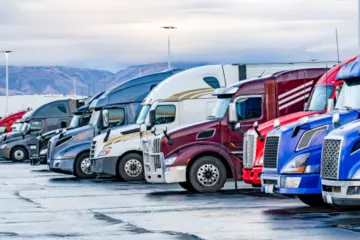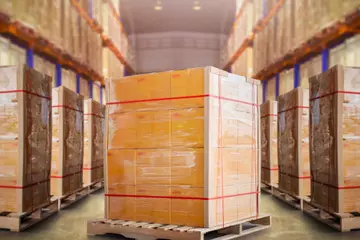Use flatbed shipping to move freight of all shapes and sizes
Sometimes you need an over-the-road solution for freight that’s taller, wider, or heavier than what fits in a standard dry van. In cases like these — where freight can also be difficult to load — flatbed shipping is the answer. A flatbed is a trailer with a flattened hauling platform, and most can be loaded from the top, sides and rear. They come in several different styles with various features to handle everything from building materials and industrial equipment to aircrafts parts and mobile homes.
Common flatbed trailer types
There are a lot of options with flatbeds trailers. An experienced logistics provider can help you determine which trailer is the best fit for your shipment, but familiarity with the most common trailers and their capabilities can let you know what to expect from flatbed service.
See what all the types look like in this infographic.
Standard flatbed
A standard flatbed is the most common, most basic and least expensive type of flatbed trailer. They’re generally 48’- 53’ long with a bed that sits at 42’’- 60’’ high. Since trailer and loading dock dimensions can both vary, a standard flatbed can often be adjusted to match dock height. They may also be equipped with a ramp to aid in loading from the ground and can typically haul freight that fits the following dimensions:
- Max weight: 48,000 pounds
- Max length: 48’ or 53’ (depending on trailer length)
- Max width: 8.5’
- Max height: 8.5’
Step deck (drop deck)
Like a standard trailer, a step (or drop) deck trailer is typically 48’ long. It gets its name from its dual hauling platforms of different heights, with the main bed being the longest and lowest of the two. This construction gives the trailer its signature “step” and makes it an ideal option for getting taller freight on the road without the need for extra permits. A step deck can accommodate freight with the following measurements:
- Max weight (total): 48,000 pounds
- Max length (upper deck): 11’
- Max width (upper deck): 8.5’
- Max height (upper deck): 8.5’
- Max length (lower deck): 37’
- Max width (lower deck): 8.5’
- Max height (lower deck): 10’
Double drop (lowboy)
The double drop trailer has a single hauling section — called the “well” — which sits 18” off the ground to accommodate taller freight like construction machinery, vehicles or aircraft parts. Because of its height and scooped design, it’s normally loaded by crane or from the sides rather than at a dock. It’s a fit for freight with the following measurements:
- Max weight: 45,000 pounds
- Max length: 28’
- Max width: 8.5’
- Max height: 12’
Removable gooseneck (RGN)
The RGN is a specialty trailer that has a removable neck to convert the front of the trailer into a ramp. This allows for easy loading of motorized freight like construction or farm equipment. While this specialization increases the cost of these trailers, easy loading can save time and keep you on schedule. The dimensions for freight on a standard removable gooseneck are:
- Max weight: 44,000 pounds
- Max length: 29’
- Max width: 8.5’
- Max height: 12’
Conestoga
A conestoga is a special flatbed trailer with an attached sliding tarp enclosure that protects freight in transit. A conestoga is mostly found on a standard flatbed or a step deck, but some RGNs also have conestoga coverings. A conestoga is often the trailer of choice for goods like steel, wiring or weather-sensitive machinery. Because the conestoga has a hard-shell tarping system, it also protects sensitive freight from the friction of a standard tarp. Dimensions can vary, but the most common conestoga freight measurements are:
- Max weight: 45,000 pounds
- Max length: 48’ or 53’
- Max width: 8.2’
- Max height: 8’
Curtainside
A curtainside is a flatbed trailer with two sliding side curtains connected to a metal ceiling. This covers the length of the trailer which is commonly 48’-53’ long. Because of its protective metal roof, the curtainside can’t be loaded from above, but its sides and rear provide dock and forklift access. Like many other types of flatbeds, the curtainside can haul lumber and other building materials, and they’re sometimes used to carry produce. Freight can typically be up to:
- Max weight: 45,000 pounds
- Max length: 48’ or 53’
- Max width: 8.4’
- Max height: 8’
Extendable (stretch)
Extendable trailers are flatbeds that can be lengthened as needed. Stretch trailers come in standard flatbed, drop deck, double drop and RGN options. Depending on the length and weight of a shipment, they can be extended with up to 20 axles to increase weight capacity for longer and heavier freight. Exact measurements and weight capacity can vary since these trailers are adapted based on a shipment’s specific needs.
Learn what other kinds of transportation equipment are available for your freight.
Flatbed shipping FAQ
How much does it cost to ship on a flatbed?
The same truckload pricing conventions apply with flatbed shipping as with dry van shipping, so your rate is made up of several market and shipment variables. However, flatbed shipping tends to cost more than a dry van since the equipment isn’t as common, they require more skill and labor to operate, and there are more permits depending on the size and type of shipment. And, the more specialized the trailer, the higher the cost.
How will my freight be secured on a flatbed?
Drivers can use straps, chains, steel strapping, synthetic cords or any other Federal Motor Carrier Safety Administration (FMCSA)-approved tiedowns. In some cases, dunnage or cribbing (planks used to lift and level) may be required to ensure your freight travels safely and securely.
Are there permits for flatbed shipping?
Permits for oversized freight are required if the total shipment (including the trailer) is larger than 53’ x 8.5’ x 8.5’ (lwh). When necessary, drivers secure permits and an approved route for all required states, and the cost is then totaled into the freight bill.
How far in advance should I book a flatbed?
Because there are fewer flatbeds on the roads than there are dry vans, it’s always best to request one as soon as you know you need it. Booking in advance will help your logistics provider source the right trailer without added costs for a last-minute booking.
How long does flatbed shipping take?
In addition to origin and destination, size and weight also play a major role in determining a flatbed’s transit time. For oversized or heavy haul shipments with travel escorts, most states limit driving hours to 30 minutes before sunrise to 30 minutes after sunset. Depending on the state, these types of shipments may also be prohibited from weekend or holiday transit.
How do I book a flatbed?
To book a flatbed shipment, it’s crucial to know your freight’s exact dimensions. This will help you choose the right equipment with the right securements, loading equipment, certifications and insurance to keep your freight protected and road legal. You should determine the following for your cargo:
- Height
- Weight
- Width
- Length
- Freight type
- Required securements/coverings
If your shipment will be damaged by chains or other potentially abrasive tiedown materials, you’ll need to inform your carrier in advance. Communicate your freight’s needs during booking to confirm your driver receives the right information.
Get the flatbed that fits your freight with ArcBest
Whether you need a trailer with a loading ramp, weather protection or more, ArcBest truckload can help you find the flatbed capacity you need. Our team of truckload experts can help you determine which trailer is right for your freight before leveraging our network of nationwide truckload partners to get your goods on the road. Learn more about our flatbed solution today.







